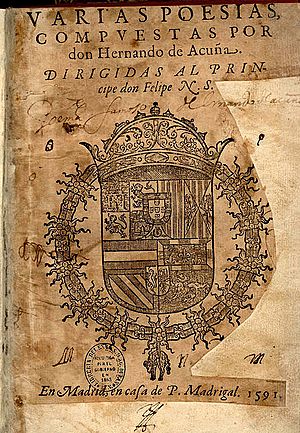Hernando de Acuña facts for kids
Hernando de Acuña (born around 1520, died June 22, 1580) was a famous Spanish poet and translator. He was born in Valladolid, Spain. He lived during a time known as the Spanish Golden Age, which was a period of great art and literature in Spain. Even Emperor Charles V admired him for his skills as both a soldier and a writer.
Life of a Poet and Soldier
Hernando de Acuña came from a noble family. When he was young, he joined the army. He fought as a soldier in Italy under Alfonso d'Avalos. This was during the War of Piedmont, a conflict between France and the Holy Roman Empire. He also served in Germany. During this time, he wrote poems for two ladies he called "Silvia" and "Galatea."
He was captured by the French army. But Emperor Charles V helped set him free. The emperor then made him the governor of a place called Querasco. In 1557, Hernando de Acuña also took part in the Battle of St. Quentin.
Around 1560, he stopped being a soldier. He moved back to Spain and married his cousin, Juana de Zúñiga. They settled in Granada. There, he and Diego Hurtado de Mendoza became the most well-known local poets. Hernando de Acuña passed away in Granada in 1580.
Literary Works and Poetry
Hernando de Acuña was one of the first Spanish poets to write in the style of Petrarch. Petrarch was a famous Italian poet. Acuña is best known for his sonnets, eclogues (poems about country life), and elegies (sad poems).
He dedicated several of his works to Emperor Charles V. One famous sonnet is "Ya se acerca, señor, o ya es llegada." This poem sums up Charles's idea of a perfect rule: "Un monarca, un imperio y una espada" (One monarch, one empire, and one sword). He was also an excellent pastoral poet, writing about the simple life of shepherds.
Acuña translated a well-known story called le Chevalier délibéré by Olivier de la Marche. He titled his translation El Cavallero Determinado. Emperor Charles V greatly admired this work. Acuña also translated writings from Ovid and Juan Boscán Almogáver. His collection of different poems was called Poesías varias.
After he died, his wife published more of his poems in 1591. A writer named Lewes Lewknor later translated some of Acuña's works into English.
See also
 In Spanish: Hernando de Acuña para niños
In Spanish: Hernando de Acuña para niños


